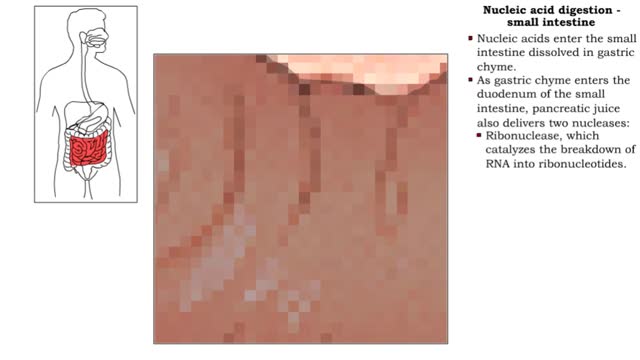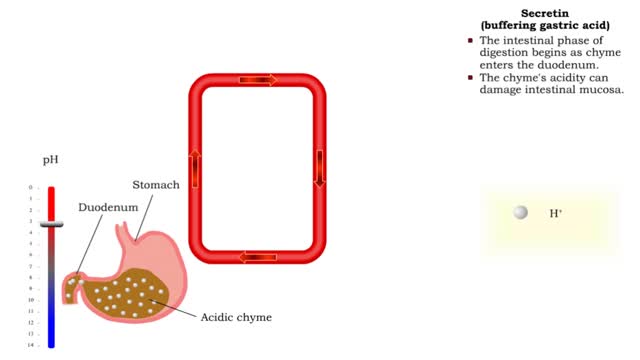Search Results
Results for: 'Pancreatic nucleases'
Nucleic acid digestion -small intestine
By: HWC, Views: 11814
Nucleic acid digestion, which takes place in the small intestine, involves: ŌĆó Pancreatic nucleases. ŌĆó Brush-border enzymes in the small intestine. ŌĆó Nucleic acids enter the small intestine dissolved in gastric chyme. ŌĆó As gastric chyme enters the duodenum of the small intestine, p...
Lipid digestion - mouth, stomach and small intestine
By: HWC, Views: 11860
ŌĆó Lipid digestion takes place primarily in the small intestine; some occurs in the mouth and stomach. ŌĆó Lipases are enzymes that break down triglycerides and phospholipids. ŌĆó Lingual and gastric lipases hydrolyze a small amount of triglycerides. ŌĆó End products are fatty acids and...
Secretin (inhibiting gastric acid secretion), Cholecystokinin (fat digestion) & Cholecystokinin
By: HWC, Views: 11564
ŌĆó As chyme approaches the small intestine, secretin also targets acid-producing parietal cells in the gastric mucosa. ŌĆó Increased secretin inhibits gastric add secretion. ŌĆó With less gastric acid produced, the chyme going into the intestine is less acidic. ŌĆó The hormone CCK also reg...
Protein digestion - stomach & small intestine
By: HWC, Views: 11247
ŌĆó Protein digestion occurs in the stomach and small intestine. ŌĆó The stomach enzyme pepsin initiates the process. ŌĆó Pancreatic and intestinal brush border enzymes complete the digestive process. ŌĆó In the stomach, pepsin is created from pepsinogen in the presence of pH-lowering hyd...
Insulin (glucose uptake by body cells), glycogenesis and lipogenesis
By: HWC, Views: 11927
Insulin is the regulator that allows the sugar from the foods we eat (be it a piece of cake or a stick of celery) to enter our tissues and become part of the metabolic process. Insulin is made by the Islets of Langerhans, which are found in the pancreas of every person. As we previously mentio...
Glucagon (glycogenolysis and gluconeogenesis)
By: HWC, Views: 11533
ŌĆó Exercise, or not having eaten recently, causes a decline in blood glucose concentration. ŌĆó Low blood glucose stimulates alpha cells in the pancreatic islets to secrete glucagon. ŌĆó Glucagon targets liver cells. ŌĆó Glucagon causes liver cells to undergo: ŌĆó Glycogenolysis, a proce...
Gastrin (gastric emptying) & Secretin (buffering gastric acid)
By: HWC, Views: 11236
ŌĆó Gastrin also binds to the smooth muscle cells in the stomach causing: ŌĆó Increased gastric motility. ŌĆó Opening of pyloric sphincter. ŌĆó Increased gastric emptying. ŌĆó The intestinal phase of digestion begins as chyme enters the duodenum. ŌĆó The chyme's acidity can damage int...
Carbohydrate digestion - mouth and stomach & pancreas and small intestine
By: HWC, Views: 11572
ŌĆó Digestion of complex carbohydrates (starches and glycogen) involves: ŌĆó Amylases produced by the salivary glands and pancreas. ŌĆó Brush-border enzymes in small intestine. ŌĆó In the mouth, amylase from the parotid and submandibular salivary glands begins carbohydrate digestion. ŌĆ...
Hormonal feedback loop components & Glucagon (glycogenolysis and gluconeogenesis)
By: HWC, Views: 11475
The endocrine system maintains many body conditions within normal limits with feedback loops. Each endocrine feedback loop maintains homeostasis using the following components: ŌĆó Stimulus - a change in a body condition. ŌĆó Production cell - an endocrine cell that produces a hormone after ...
Advertisement











